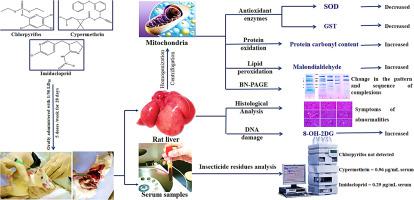Pesticide Biochemistry and Physiology ( IF 4.2 ) Pub Date : 2021-07-20 , DOI: 10.1016/j.pestbp.2021.104938 Mostafa A I Taha 1 , Mohamed E I Badawy 2 , Reda K Abdel-Razik 3 , Hassan M Younis 1 , Mahmoud M Abo-El-Saad 1

|
The adverse effects of chlorpyrifos, cypermethrin, and imidacloprid on mitochondrial dysfunction and oxidative stress biomarkers were studied in rat liver. The liver deficiency was also confirmed by histological analysis and gel electrophoresis. Each insecticide was administered orally with five doses per week for 28 days to male albino rats at 1/50 of the LD50 per insecticide. The results demonstrated that the mitochondrial dysfunction was confirmed by a significant decrease in NADH dehydrogenase and ATPase activities. Oxidative stress biomarkers include malondialdehyde (MDA), and protein carbonyl content (PCC) were significantly increased. However, superoxide dismutase (SOD) and glutathione S-transferase (GST) as antioxidant enzymes were significantly decreased in the mitochondria of the rat liver. HPLC analysis showed a significant increase of the 8-hydroxy-2′-deoxyguanosine (8-OH-2DG) as a biomarker of the DNA damage in rat liver. In addition, the residue levels of 0.96 and 0.29 μg/mL serum were found for cypermethrin and imidacloprid, respectively. However, chlorpyrifos not detected using the HPLC analysis. Blue native polyacrylamide gel electrophoresis (BN-PAGE) analysis showed a change in the pattern and sequence of complexions of the electron transport chain in liver mitochondria with treatment by such insecticides. The hepatic histological examination also showed symptoms of abnormalities after exposure to these insecticides.
中文翻译:

毒死蜱、氯氰菊酯和吡虫啉亚慢性中毒后雄性白化大鼠肝脏线粒体功能障碍和氧化应激
在大鼠肝脏中研究了毒死蜱、氯氰菊酯和吡虫啉对线粒体功能障碍和氧化应激生物标志物的不利影响。通过组织学分析和凝胶电泳也证实了肝缺陷。每种杀虫剂以 LD 50 的1/50 每周向雄性白化大鼠口服五剂,持续 28 天每杀虫剂。结果表明,NADH脱氢酶和ATP酶活性的显着降低证实了线粒体功能障碍。氧化应激生物标志物包括丙二醛(MDA)和蛋白质羰基含量(PCC)显着增加。然而,作为抗氧化酶的超氧化物歧化酶 (SOD) 和谷胱甘肽 S-转移酶 (GST) 在大鼠肝脏线粒体中显着降低。HPLC 分析显示 8-羟基-2'-脱氧鸟苷 (8-OH-2DG) 作为大鼠肝脏 DNA 损伤的生物标志物显着增加。此外,氯氰菊酯和吡虫啉的残留水平分别为 0.96 和 0.29 μg/mL 血清。然而,使用 HPLC 分析未检测到毒死蜱。蓝色天然聚丙烯酰胺凝胶电泳 (BN-PAGE) 分析显示,用此类杀虫剂处理后,肝线粒体中电子传递链的模式和序列发生了变化。肝脏组织学检查也显示接触这些杀虫剂后出现异常症状。











































 京公网安备 11010802027423号
京公网安备 11010802027423号